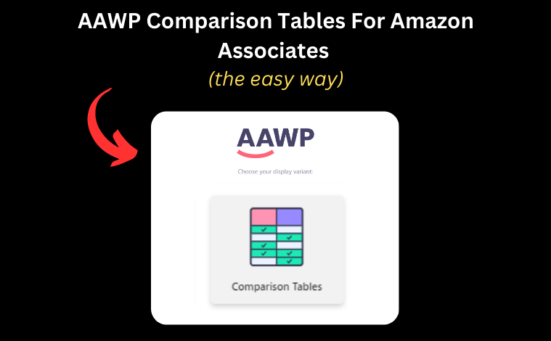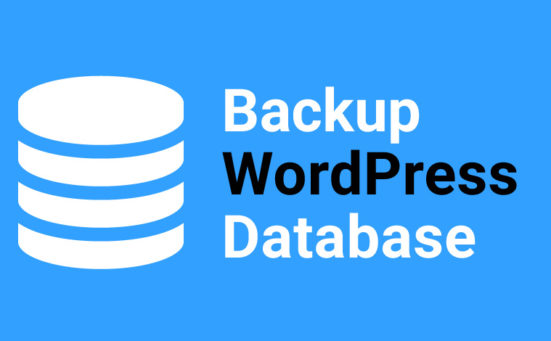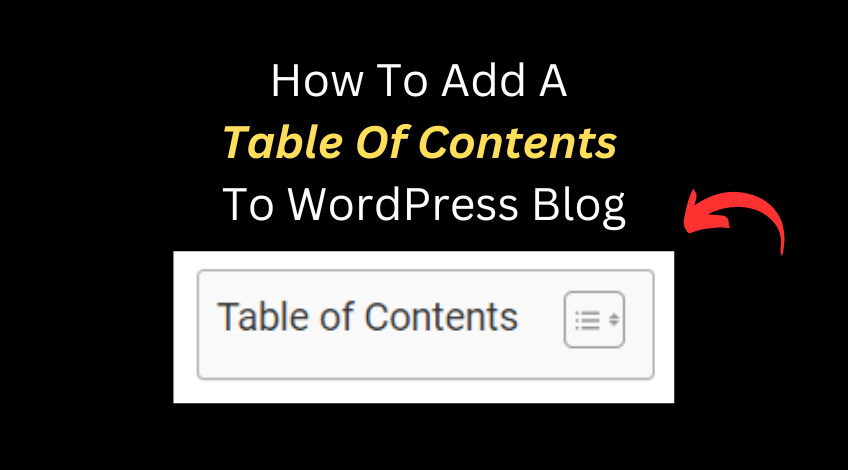
In this article, I’m going to show you how to add yet another awesome feature to your WordPress blog: A Table of Contents.
You may have seen it everywhere on thousands of websites that you may be wondering, why add them to yours?
Although you may initially think that they are not worth the extra trouble, let me say it this early: Adding a Table of Contents feature to your blog can be VERY beneficial for SEO and user experience.
They are not even difficult to add in the first place! With just a simple plugin, your website can be more attractive and functional – without having to spend money.
Why do you need to Add a Table of Contents to your Blog?
Before going into detail about how you can add a Table of Contents (or ToC) to your blog, let’s see why they are worth adding in the first place.
From a Search Engine Optimization perspective
In an SEO perspective, a Table of Contents can significantly improve the click-through rate (CTR) of your website. This is because the feature can give you the option to add “sitelinks” to your content and SERP listing.
Sitelinks help users jump into the relevant information that they’re looking for. This can all be done with just one click from the search results.
You can see this here:
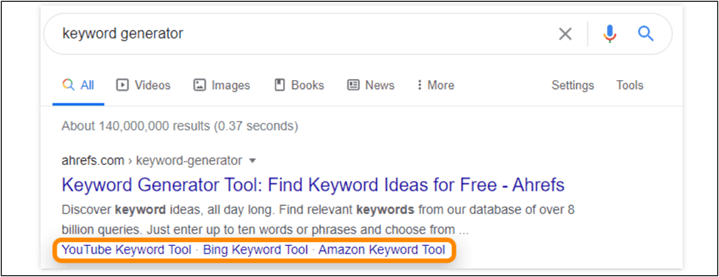
In this example, we are looking for “keyword generator” in Google.
One of the top-ranking pages displays an option to click immediately to the section of the article – the ones we call sitelinks, that are talking about “YouTube Keyword Tool”, “Bing Keyword Tool”, and “Amazon Keyword Tool” without having to click on the post and manually looking over the content.
If I’m looking for, let’s say, an Amazon Keyword Tool, I can immediately see and go to where I need by just clicking on the linked suggestion on the snippet.
This is possible because a Table of Contents is added to the blog.
As you may also notice, the SERP listing appears to be bigger as it is showing up the sitelinks for the post. Without it, the space for the post will be significantly less, making it not as appealing or eye-catching for visitors.
Without the sitelinks, this is how the same blog post will appear from the SERP:
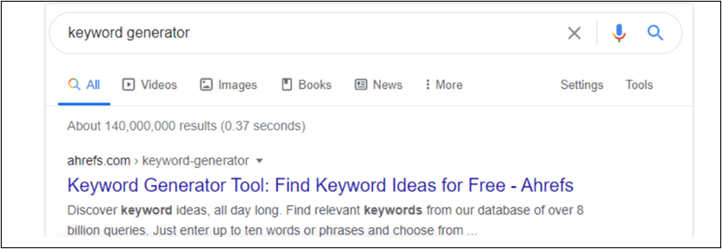
Did you notice the difference between the two listings? Having no sitelinks makes it appear similar to the generic listings in the search engine.
From an SEO standpoint, this is not good. Why? Because you have to stand out from the rest of the other articles in the list.
Without the ToC, you are wasting the opportunity to have a unique and more appealing SERP listing that will bring more traffic to your site.
From a usability perspective
Generally, the visitors on your site are in a hurry to have the reason why they visited your blog to be satisfied.
When they are asking a question, they want the answers immediately.
When they are looking into how things are done, it is best to show them the steps as soon as they click on your page.
This is exactly one of the reasons why adding a Table of Contents in your page is absolutely worth the effort.
When your users can immediately have a look at what your content is all about and what kind of information is ready for their viewing and consumption, they are more likely to stay at your page.
Let me show you an example using one of my recent blog posts, 26 WordPress Blog SEO Tips That I Wish I Knew Earlier, as a reference.
Here is the introduction of the blog post:
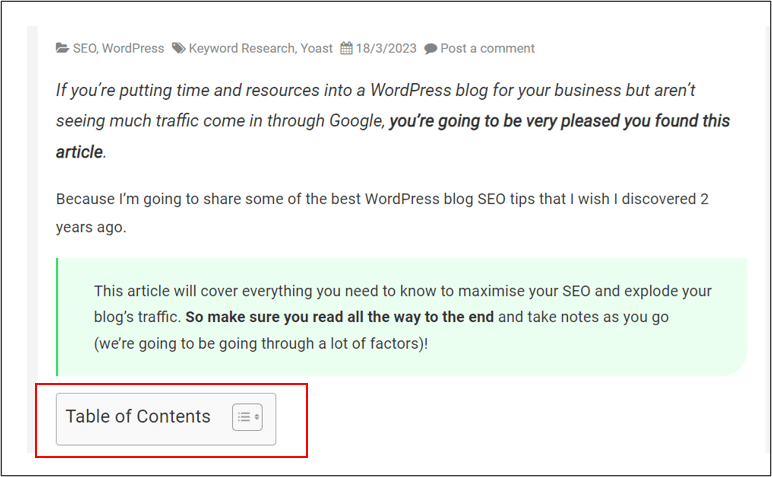
After my short introduction of the article, my site visitors can have a look at the ToC to have a better idea of what I’ll be talking about in my post by clicking on it.
Then from the list, they’ll see the hierarchy of info I’ll be talking about.
If one of my users wants to know more about, let’s say, my tips for fixing broken links, all they have to do is click on the topic…

…then they will be able to read about that particular section in my blog post!
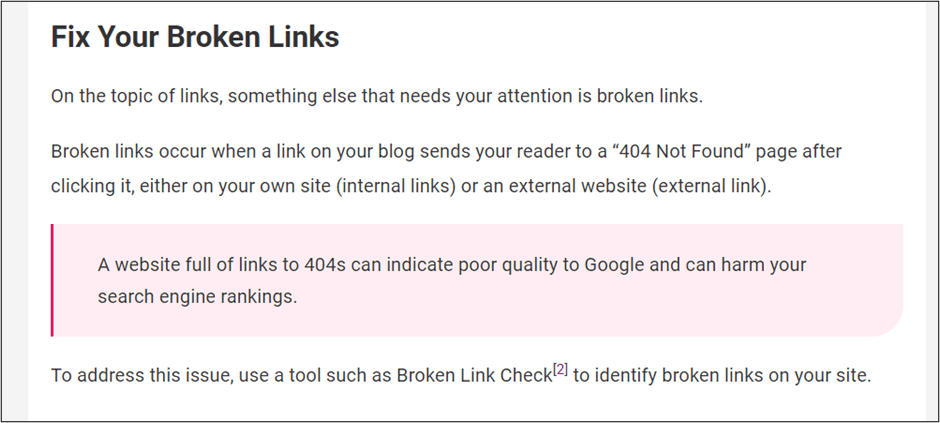
How cool – and time-efficient is that?
How to Add a Table of Contents using a Plugin
Now that you know how adding a Table of Contents on your blog can be great for SEO and user experience, let me show you how it’s done.
My favorite way of adding a Table of Contents is by using a plugin called Easy Table of Contents by Magazine3[1]. I have been using this plugin now across all my websites and find it to be the easiest one to install and use.
How to Install Easy Table of Contents
- First, go to the WordPress dashboard of your website.
- On the Navigation Menu (found on the left side), hover your mouse on Plugins, then click on Add New.
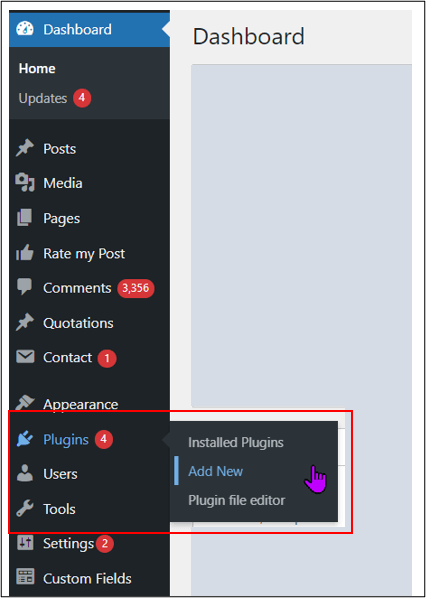
- Search for Easy Table of Contents on the search bar, then click on Install Now. (Since I have already installed the plugin, the option showing here is for updating it.)
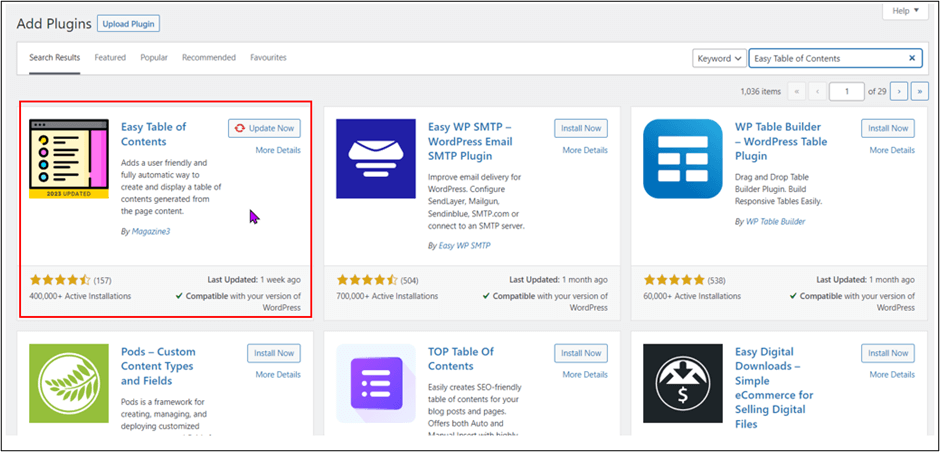
- Once the plugin is installed, you now have the option to see Table of Contents in Settings. Click on Table of Contents to change its General Settings, Appearance, and more!
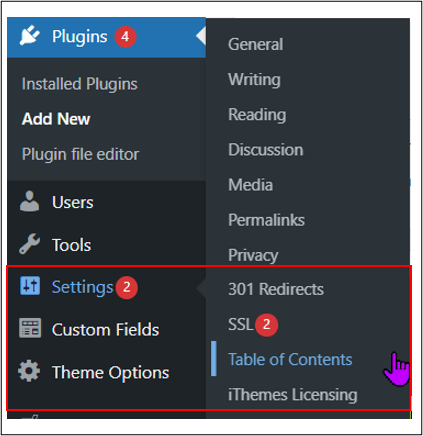
How to Customize your Table of Contents
Changing the settings of the plugin is very easy.
All you have to do is tick (or untick) a particular setting in order to activate or deactivate whatever feature it is that you want to customize.
General Settings
Enable Support
On the General settings of the plugin, the first thing you’ll see is Enable Support.
This mainly concerns the parts of your blog wherein the Table of Contents will be allowed to show.
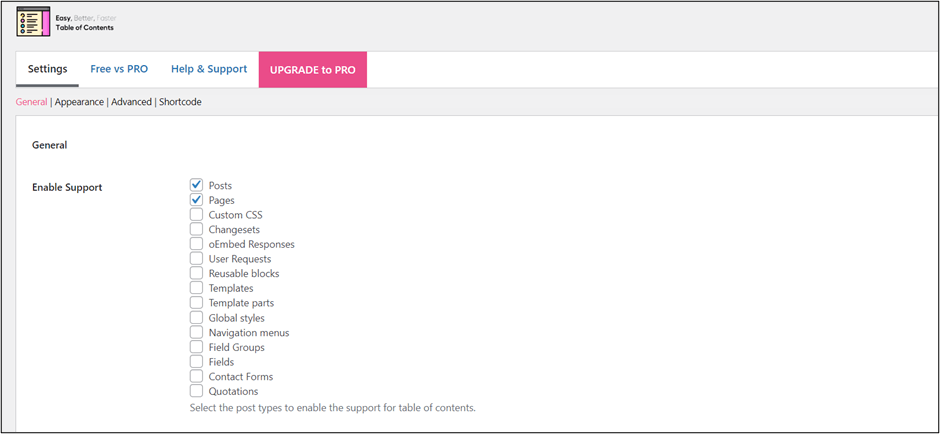
As you can see, you can add it on all the sections mentioned in the list.
Personally, I like to add ToCs only on some of the Posts and Pages on my websites, which is why these two are the only options I kept ticked on.
Auto Insert
The second thing you’ll see in the General Settings is Auto Insert.
This is where you’ll configure if you want to automatically add the Table of Contents on particular sections of your blog.

For me, I like to have the option of adding it manually on my pages, which is why I didn’t change anything for this part.
If you’d like to add ToCs on all your pages, for example, just tick the Pages for it to show.
Position
Do you want to choose where to specifically place your Table of Contents? Click on Position, then look through all the options.
You can choose to add it before or after the first heading, after the first paragraph, or at the top. If you want, you can even add it at the bottom of your pages!

Show when
The number you choose for this setting will be the trigger point as to when the Table of Contents will be displayed.

In the setting above, I chose the number “4”. This will mean that my ToCs will be displayed if I have 4 or more headings present on my page.
This also means that there will be no Table of Contents for my posts that have 3 or fewer headings. This is because I think that they are unnecessary at that point.
The setting above is just based on my preference. Feel free to easily change this depending on what suits your need or piece of content.
Other General Settings
When I tell you that the customization is almost endless for this plugin, you better believe me.
You can choose what matches your brand or website more by configuring the following settings of your Table of Contents:
- Display Header Label
- Header Label
- Toggle View
- Initial View
- Show as Hierarchy
- Counter
- Smooth Scroll
- TOC Loading Method
- Sticky Toggle Options
Here is the stuff you can tweak with for the general settings:
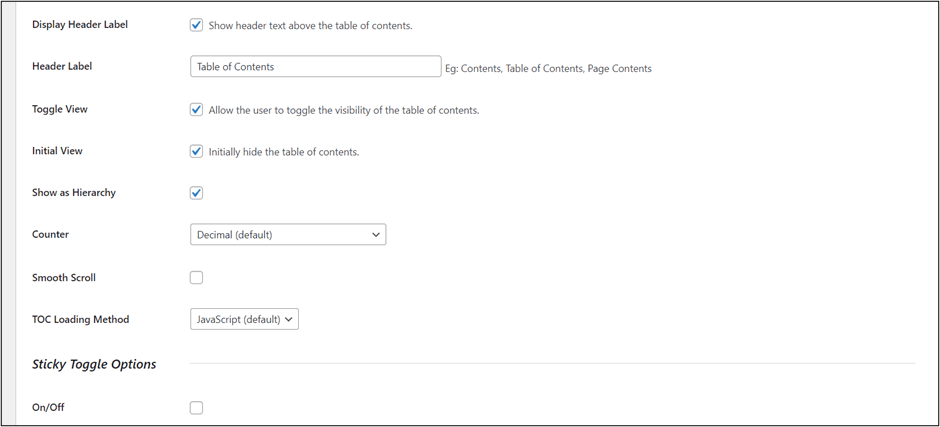
As mentioned, all you have to do is tick (or untick) to activate the options.
Appearance
Of course, if you want the Table of Contents to fit seamlessly on your page, you also have the option to change its appearance, such as the:
- Width and Alignment
- Font Option – sizes and weight
- Theme Options – you can choose from Grey, Light Blue, White, Black, Transparent, or even do a custom one!
Check out your options:
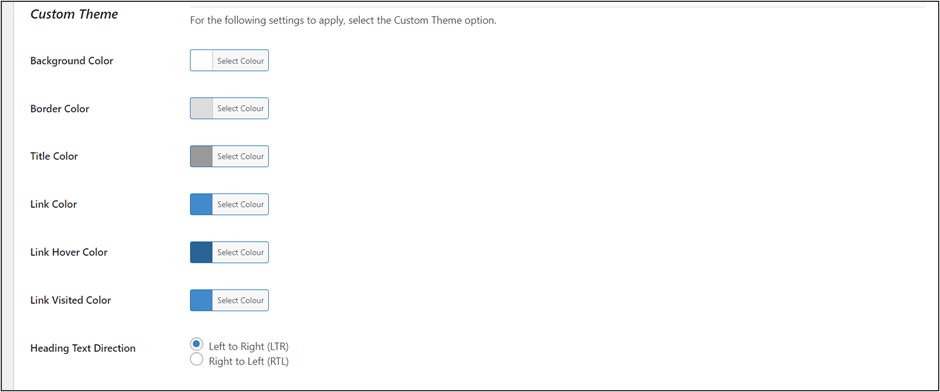
Advanced Settings
Do you really want to take customization to the next level? No worries.
You can certainly change various settings, including the option to use lowercases, hyphens, show the ToC on the homepage, tweak with CSS, add shortcodes, and so much more.
I’ll leave the exploring to you, but here are some of the other options you can change to your preference.
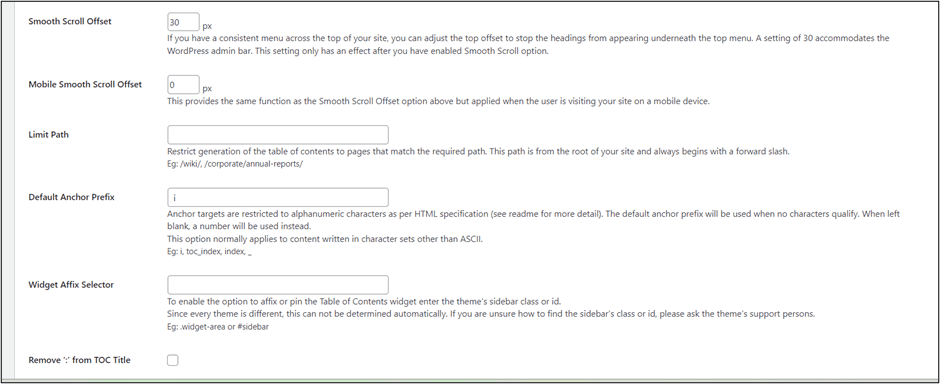
Don’t Forget to Save Changes!
Once you’re done changing the settings of your Table of Contents to your liking, do not forget to click on Save Changes at the very bottom so that your settings will be saved.
If you selected the Auto Insert option, all you have to do is save your settings and refresh your page. Go to the post where you wanted to add the Table of Contents and see if it is already there.
It should look like this:
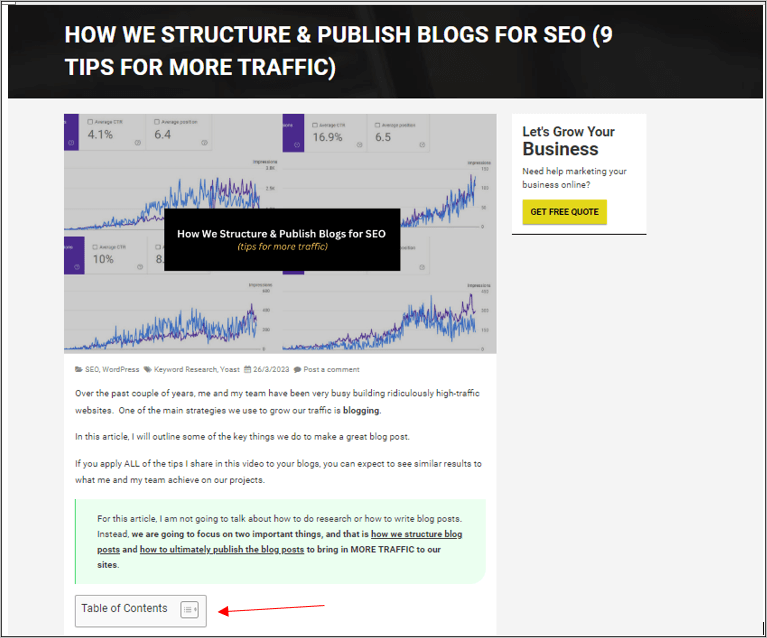
What happens if you did not select the Auto Insert Option?
If you did not select the “Auto Insert” option, you have to remember to enable the Table of Contents setting on every page you choose to put it in, or it will not be displayed.
For example, if you want to add it to a blog post, click on Edit Post, scroll to the bottom, and tick on Insert table of contents.

After ticking the option on, click Update, refresh your page, and check if the Table of Contents is already displayed.
That’s it! Now you can add your Table of Contents to every blog post, page, or other section of your website.
Do you have any questions?
With just a few clicks, a Table of Contents can significantly help increase traffic and improve user experience in your blog.
All you need to do is install the Easy Table of Contents plugin, customize the bits to your liking, and make sure that it’s working well, and you’ll have a blog that is both accessible and functional for your visitors.
I hope that this tutorial allows you to start working on optimizing you WordPress blog. Let me know in the comments if you have any questions!
SEE MORE: How We Structure & Publish Blogs for SEO (9 Tips for more Traffic)
Frequently Asked Questions
In blogging, the two main purposes of a table of contents are improving SEO and user experience by giving them an overview of the content.
Not all blog posts need to have a table of contents. It will depend on the content of your blog. Usually, including a ToC is recommended for lengthy blog posts that are more than 1,500 words.
You can add a table of contents in WordPress without plugins by doing it manually and using HTML anchor links.
The best way to structure your blog post is to use appropriate headings, have a catchy intro, make your paragraphs digestible, and have a good call to action for your readers.
To ensure that you are organizing your content in WordPress effectively, the main thing to focus on is using proper Headings. Use your H2s, H3s, and H4s.

